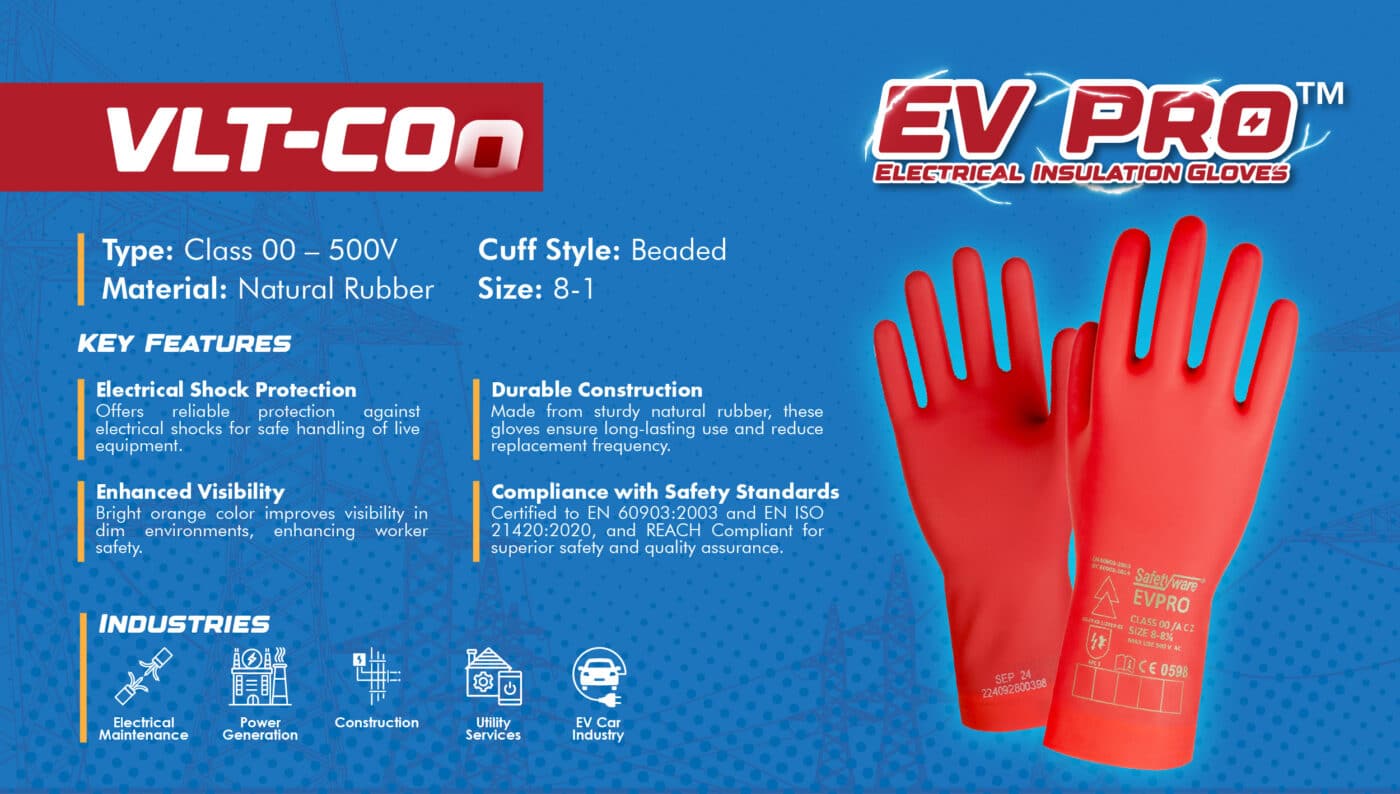When working with electrical systems, insulating gloves are critical for protecting against shocks, arcs, and electrocution. However, not all gloves are created equal. The ASTM D120 standard categorizes insulating gloves into six classes (Class 00, 0, 1, 2, 3, and 4), each designed for specific voltage levels and workplace hazards. Choosing the right class is a matter of safety—and sometimes life or death. Let’s break down what sets these classes apart and how to select the proper protection for your job.
Why Insulating Glove Classes Matter
Insulating gloves are rated based on their maximum use voltage (the highest voltage they can safely handle) and test voltage (the voltage they endure during rigorous safety testing). Using a glove rated below your work environment’s voltage risks catastrophic failure, while over-specifying may lead to unnecessary bulk and reduced dexterity.
Class 00 to Class 4: Key Differences
1. Class 00
- Max AC Use Voltage: 500 volts
- Test Voltage: 2,500 volts
- Color Code: Beige
- Thickness: ~0.5 mm (thin for flexibility)
- Typical Use: Low-voltage tasks (e.g., testing circuits, minor repairs on small electronics).
2. Class 0
- Max AC Use Voltage: 1,000 volts
- Test Voltage: 5,000 volts
- Color Code: Red
- Thickness: Slightly thicker than Class 00
- Typical Use: Basic electrical maintenance (e.g., residential wiring, control panels).
3. Class 1
- Max AC Use Voltage: 7,500 volts
- Test Voltage: 10,000 volts
- Color Code: White
- Thickness: ~1.1 mm
- Typical Use: Medium-voltage applications (e.g., substation work, transformer maintenance).
4. Class 2
- Max AC Use Voltage: 17,000 volts
- Test Voltage: 20,000 volts
- Color Code: Yellow
- Thickness: ~1.5 mm
- Typical Use: High-voltage power lines, utility pole work.
5. Class 3
- Max AC Use Voltage: 26,500 volts
- Test Voltage: 30,000 volts
- Color Code: Green
- Thickness: ~2.3 mm
- Typical Use: Transmission line maintenance, industrial high-voltage systems.
6. Class 4
- Max AC Use Voltage: 36,000 volts
- Test Voltage: 40,000 volts
- Color Code: Orange
- Thickness: ~3.0 mm (heaviest for maximum insulation)
- Typical Use: Extreme high-voltage environments (e.g., power generation plants, utility hot-stick work).
Comparison Table: Class 00 to Class 4
| Class | Max AC Voltage | Test Voltage | Color | Thickness | Common Applications |
|---|---|---|---|---|---|
| 00 | 500 V | 2,500 V | Beige | ~0.5 mm | Low-voltage electronics, diagnostics |
| 0 | 1,000 V | 5,000 V | Red | ~0.8 mm | Residential wiring, control panels |
| 1 | 7,500 V | 10,000 V | White | ~1.1 mm | Substations, transformers |
| 2 | 17,000 V | 20,000 V | Yellow | ~1.5 mm | Power lines, utility maintenance |
| 3 | 26,500 V | 30,000 V | Green | ~2.3 mm | Transmission lines, industrial systems |
| 4 | 36,000 V | 40,000 V | Orange | ~3.0 mm | Power plants, extreme high-voltage |
Critical Safety Tips for Insulating Gloves
- Pair with Leather Protectors: Always wear leather over-gloves to prevent physical damage (cuts, punctures) to the insulating layer.
- Inspect Before Use: Check for holes, tears, or swelling. Perform an air test by rolling the glove to detect leaks.
- Retest Regularly: Gloves must be retested every 6–12 months (per OSHA 1910.137) to ensure integrity.
- Match Class to Voltage: Never use a Class 00 glove for 1,000V+ work—it can lead to fatal arc flashes.
- Store Properly: Keep gloves in a cool, dark place away from chemicals, sunlight, or moisture.
Choosing the Right Class
- Class 00/0: Ideal for low-voltage environments (e.g., HVAC technicians, electricians in homes).
- Class 1/2: Suited for utility workers, substation operators, or industrial electricians.
- Class 3/4: Reserved for specialized high-voltage crews (e.g., transmission line workers, power plant engineers).
Looking for Insulating Gloves?

Empower your electrical safety with Safetyware Insulating Gloves—engineered to protect against life-threatening shocks and arc flashes in high-voltage environments. Designed to meet ASTM D120 and EN 60903 standards, our gloves are rigorously tested for dielectric strength, durability, and ergonomic comfort, ensuring compliance and reliability in the most demanding workplaces
Final Thoughts
Insulating gloves are your first line of defense against electrical hazards—but only if they’re correctly rated for the job. Understanding the differences between Class 00 to Class 4 ensures you’re neither under-protected nor overburdened by unnecessary bulk. Always prioritize compliance with ASTM and OSHA standards, and never compromise on glove inspections. Remember: in electrical work, the right glove isn’t just PPE—it’s a lifeline.
Stay charged with safety! ⚡🧤
For more updates on safety news and insights, visit our website at Safetyware.
Any Questions? Contact Us:
📩 Email: [email protected]
🌐 Website: www.safetyware.com
📞 Contact us: WhatsApp

